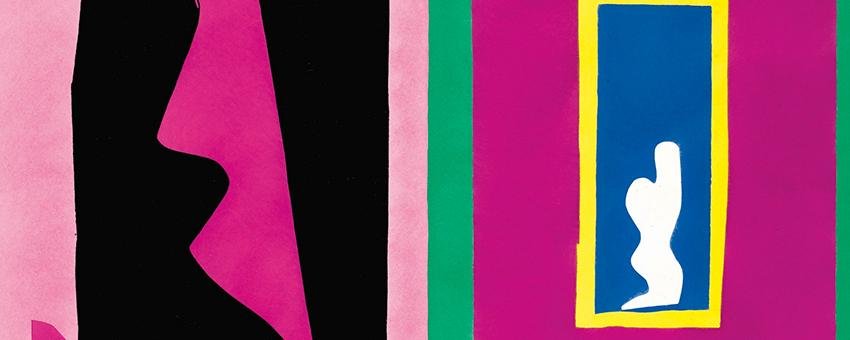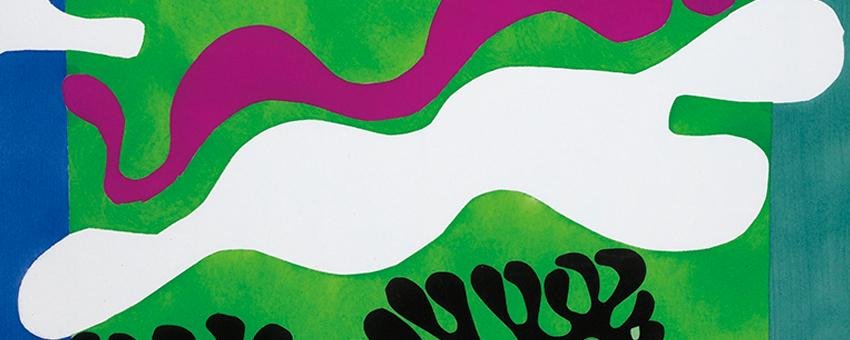Henri Matisse: Jazz
Logan Center Lower Level
Ongoing
Gifted by the Reva and David Logan Foundation, a rotating selection of Henri Matisse’s Jazz prints will be on permanent display at the Logan Center.
Reva and David Logan’s collection of modern illustrated books was “one of the most important ever formed in the United States and a manifestation of their passion for volumes where inspired text joins creative original graphic art to form a unified whole.” Jazz is “Matisse’s most important artist’s book because it is the only one that he is both author and illustrator...Matisse started on the project in mid-1943. It was conceived as an album of twenty plates and Matisse wrote the accompanying text in 1946, providing a revealing commentary on his subjects, method and philosophy.
In his notes forming the imposing handwritten text, he wrote ‘these images, with their lively and violent tones, derive from crystallization of memories and circuses, folktales and voyages.’” Matisse created a series of paper cutouts and papier découpés, which were published in Jazz, a 1947 limited-edition book that contained his written memoirs and color pochoirs. Matisse titled this series Jazz because it suggested a connection between art and musical improvisation. The combination of vivid colors and abstract composition evokes a glorious celebration of life against adversity, making the Jazz prints one the most groundbreaking series of 20th century art. In addition, many of the works depict motifs concerning performing artists.
As an enduring legacy to David, Reva, and the entire Logan family, displaying the Matisse prints at the Logan Center celebrates both jazz and the arts and creative collaboration more broadly.
Reflections on Matisse's Jazz
Christine Mehring, Department Chair and Professor of Art History and the College, University of Chicago
"From his Fauve paintings of 1905 until his death in 1954, Henri Matisse strove to achieve, even to exceed, the limits of coloristic intensity. In his later years, he turned to cut-paper collages as a way of working directly with shape and color. He saw these so-called cut-outs as the culmination of all his endeavors in paint: “There is no separation between my old pictures and my cut-outs, except that with greater completeness and abstraction, I have attained a form filtered to its essentials…”
Matisse had used shapes cut from colored paper in the early 1930s in preparing his Dance murals for the Barnes Foundation in Philadelphia, but it was in Jazz that the cut-out technique became a full-fledged medium. Encouraged by friend and publisher Tériade to illustrate a book, Matisse in 1943–44 made a series of stencil designs depicting circus and folklore motifs. (The jazz title seems to have been Tériade’s idea.) A book of twenty color plates, accompanied by a text handwritten by the artist himself in 1946, was published in September 1947, and it has since been reproduced as a trade edition.
By cutting out figures, planes, and ornamental patterns from paper that had been pre-painted by his assistants, Matisse “drew with scissors,” as it were, in “one movement linking line with color, contour with surface.” Color is not opposed to line, not dominated by outlines, in the cut-outs. As Matisse said, collapsing the old hierarchy established in the Renaissance, color must not “simply ‘clothe’ the form: it must constitute it.”
Each print in Jazz overwhelms us with its dazzling colors. Our eyes jump from one area to the next and back, especially in busier pages like The Nightmare of the White Elephant or Horse, Horsewoman and Clown. But this also happens, more subtly, in Monsieur Loyal, as our eyes move back and forth trying to negotiate the minute tonal differences between the small yellow and orange circles. Where color intensities are equal, figure and ground become hard to distinguish. White becomes a color, no longer a background, in The Swimmer in the Aquarium. The use of left-overs of previously cut-out shapes (The Clown, The Lagoon) adds to the confusion.
Especially when looking at Jazz as a book or a set of prints in a box, but even in the pages of a catalogue or displayed along a wall: each print overstimulates us. Each color configuration is unexpected and all-consuming, and makes the previous one fade in our mind’s eye. While Matisse’s large late cut-outs and decorative schemes suggest a timeless world of simplicity and harmony, Jazz is as restless as its circus inhabitants or the music of its title.
This is the slightly modified version of a text first published in Modern Art at Harvard, exh. cat. (Tokyo: Nihon Keizai Shimbun, Inc., 1999.)
A List of Works in the Series
I Le Clown (The Clown)
II Le Cirque (Circus)
III Monsieur Loyal
IV Le Cauchemar d l’éléphant blanc (The Nightmare of the White Elephant)
V Le Cheval, l’écuyère et le clown (Horse, Rider and Clown)
VI Le Loup (The Wolf)
VII Le Coeur (The Heart)
VIII Icare (Icarus)
IV Formes (Forms)
X L’Enterrement de Pierrot (Pierrot’s Funeral)
XI Les Codomas (The Codomas)
XII La Nageuse dans l’aquarium (The Swimmer in the Tank) XIII L’Avaleur de sabres (The Sword Swallower)
XIV Le Cow-boy (The Cowboy)
XV Le Lanceur de couteaux (The Knife Thrower)
XVI Le Destin (Destiny)
XVII Le Lagon (I) (Lagoon)
XVIII Le Lagon (II) (Lagoon)
XIX Le Lagon (III) (Lagoon)
XX Le Tobogan (Toboggan)



